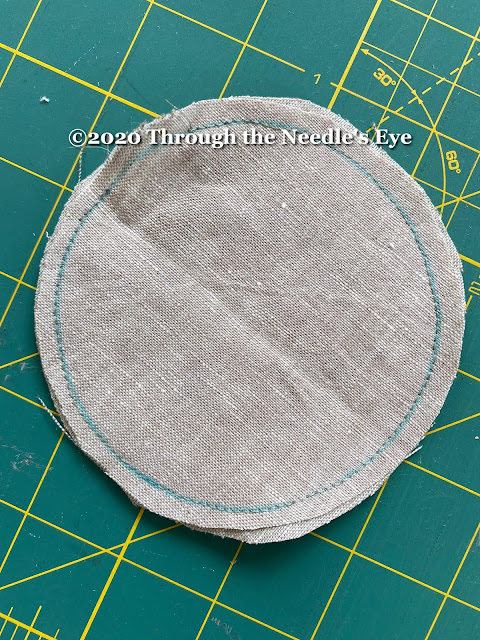It's finally time to reveal our block for the Woolen Oak Mystery Stitch-A-Long! It has been SO hard to keep our Harvest Basket block a secret. We hope you enjoy making it as much as we did! To download your free pattern, click
here. Just add the free download to your cart,
be sure to add the promo code FREE when you go to the checkout, and the price will revert to zero. Best way to shop!
In honor of our Woolen Oak Block reveal, we thought it might be nice to show you how we prepare our wool for appliqué. Both of us use a variety of methods based on a few variables—the size of the piece, the type of wool, and truthfully, our mood for that day might dictate which method we use. Sometimes we use the same process, but most often we stick to the method that works best for each of us. I (Kara) like to use freezer paper for my templates and for many projects, I will use fusible. Teri goes about her prep a little differently, so today we thought would each show you our favorite methods.
Kara
I start out with my template page, a glue stick and a piece of freezer paper.
I apply glue to the back of all the template pieces (or the whole sheet of paper).
Next I place the template sheet on the matte side of the freezer paper.
Then I cut out a chunk of the templates, so I am working with a smaller piece,
and then cut out the individual pieces.
 |
Cut out and ready to iron onto the wool.
|
 |
An easier to manage chunk.
|
If I am using fusible, I make sure that my wool has the fusible already applied with the paper still on. Then I iron on my freezer paper template to the wool.
After the template is ironed, I cut out each shape.
Once I have used my templates, I keep them in a bag and then I am able to use them again, or if I need to change out a color, I just pull that template out.
This is just one way of preparing wool for appliqué. I like using this method because I always have the templates available to use whether I choose to use fusible or not. If I am not using fusible, I will staple my pieces to my background. I am not a very good tracer, so I tend to stay away from tracing and my brain doesn't like to reverse images accurately, so this method works well for me. I keep the template bag in with my pattern, in case I decide to make the project again. It is not necessarily the fastest method, but it is important to find the method that works best for you and your brain!
Teri
While Kara has the tidier brain, mine tends to want to find the way that offers me more efficiency. (Translation: I am "lazier" and don't like to go back and forth to my ironing board if I can avoid it.) There are certainly times that I find Kara's method to be the best, but for the most part, I have a much closer relationship with my stapler than my iron. (Again, it is more portable, so I can stay in my living room chair.) It may also have to do with the fact that my hand hurts more if I am cutting through multiple layers of paper. I can find excuses for anything...
The Harvest Basket block involved several elements that required a different kind of attention, so I used several methods. Most of the time, I do not use fusible; I staple the units onto my block. For this block, the two sections I knew that I would fuse were the basket (video to follow) and the grapes, since there were so many of them and they were small. So I ironed the fusible to the back of the brown for the basket and the purple for the grapes. The rest of the pieces, I left naked. This is how I approached prepping the block for appliqué.
First, I cut out one of each unique template. For this block, I cut out all the smaller basket templates, and then realized I really only needed to cut one, as they were all the same, so for the longer templates, I cut one and reused it.
I bend the staple as pictured below, which makes it pretty easy to remove. I can then restaple the template onto the wool to cut another identical unit, if needed.
The grapes were a bit different. Since there were so many of them, I thought I would use Kara's method, as stapling might have been more challenging. So I glued the templates to freezer paper and was ready to start cutting. Then I noticed that there were only two sizes of grapes, so rather than cut all the templates, iron them on, and cut the grapes, I just cut one of each size and traced the required number of each sized grape onto the back of the fusible. Cutting was then easier on my hand. Having glued the template onto freezer paper did give me a stronger template for tracing.
For the rest of the templates, I stapled them onto the wool, cut out the units, and reused the template when needed. You can see the multiple staple marks on the templates in the picture below.
For the yellow flowers, I cut the template first to ensure better accuracy, since the petals were small. But I often just staple as below and cut only once. I have a designated pair of sharp scissors that I use when I'm cutting through paper as well. I was so excited about stitching my Harvest Basket block that I neglected to stop and take pictures for you, so here is an example from our
Hopeful Bluebird.
I also keep all of my templates in a bag with the pattern, in case I want to make the block again. I include the pieces I haven't used, in case one wears out from too many staplings. I haven't had that happen often, though.
Appliquéing the Block
For this block, Kara fused everything down before appliquéing. I (Teri) fused the basket and the grapes, but I stapled the rest of the pieces in place and then appliquéd. If there are layers, I staple and appliqué the bottom layer, like the pumpkin first, and then staple the leaves in place. We both use an appliqué stitch with matching thread or one strand of matching floss to appliqué our pieces in place, as typically, we want the focus of our stitching to be on the embroidered embellishments.
The staple holds the pieces in place while appliquéing, and does not catch the thread as a pin would. They are easy to remove and leave no marks on the fabric.
 |
No evidence of the staples
|
In some situations, if we have a more loosely woven wool, we might use a blanket stitch with matching floss to help to smooth the edges a bit. The green for the leaves was the only wool we used which was not hand-dyed, so we blanket-stitched it to give it a cleaner edge. We wanted the focus to be on the embroidered veins, so you can't really see the blanket stitch, as it melts into the matching wool.
The most unique aspect of the appliqué on this block is the basket. Since many baskets are woven, it gave us an opportunity to weave some wool. Kara made a video to demonstrate how she created the basket. We hope you enjoy it!
Be sure to watch out for videos throughout the week on our
Facebook page, giving tips about the Harvest Basket block. If you haven't joined
Woolen Oak Mystery Stitch-A-Long group on Facebook, you're missing out on a lot of inspiration and fun!
































































